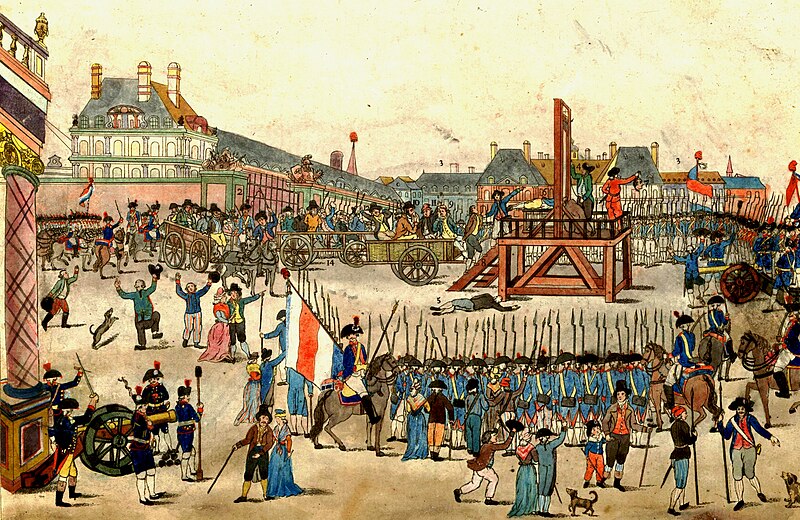 |
| 1792 guillotine |
What do most people think of when they hear the word “France?” The Eiffel Tower. Snails. The Louvre. Guillotines. Berets. Sidewalk cafes. La Marseillaise. There is much more to the country than this. They have a rich history and culture. They have gorgeous countryside and amazing works of art. Their capitol doubles as the fashion capitol of the world, in addition to being the birthplace of the modern restaurant.
This day in history in 1792 was a big day for France. Not for everything associated with it, since the Eiffel Tower wouldn’t be constructed for another hundred years or so, snails have been eaten in the Mediterranean since before man started counting time, and berets became a fashionable thing to wear with your military uniform in the 1800s. On April 25th, 1792, two things that were a big part of France’s history happened: La Marseillaise was composed, and for the first time, the guillotine was used as a means of execution. Both of these things had a huge impact on the history of the country, and the world.
Listening to another country’s national anthem is not really something that people (especially Americans) do. Chances are, if you’re an average American, you’ve never heard, say, the national anthem of The Netherlands, which is a song about defeating Spain in battle (it was pretty cool to watch them sing it before the start of the World Cup final in 2010, but then sad because Spain won the game). But you definitely know the tune of the United Kingdom’s national anthem, which is called God Save the Queen, because in our American sassiness we changed the words and turned it into our own patriotic song, My Country ‘Tis of Thee.
And you’ve heard La Marseillaise. Its famous musical phrase goes “DA DA DA DAAA DAAA DAA DAA DAAAAAAAA DA DA” and has been in tons of cartoons starring Bugs Bunny, Daffy Duck, and the like. The Beatles borrowed it for the intro to All You Need is Love. Even Metallica has done a cover.
 |
| "Of all the gin joints in all the towns in all the world, you had to have a song battle in mine." |
One place you can be sure to find it is in the cinematic classic Casablanca, which is required viewing for... well, everyone in the world. The famous scene takes place at Rick’s, the top hot spot for the elite citizens of French Morocco. A group of Nazi officers are boisterously singing the anthem of the Third Reich while the rest of the crowd watches submissively, until one man orders the band to strike up La Marseillaise, and everyone else in the room joins in the song and drowns out the voices of the German officers.
A guillotine, in case you didn’t know, is a contraption used to end someone’s life by parting their head from the rest of their body. Public execution was the norm in those days, and surprisingly, a gruesome guillotine was considered a more humane way of execution. I suppose criminals preferred it to being burned at the stake or being beaten to death on a wheel. And previous death-by-decapitation methods were by axe or other weapon of questionable sharpness, which sometimes took several whacks to complete the job.
 |
| The execution of Robespierre and his supporters |
There was already political unrest in France prior to the first use of the guillotine as a means of public execution, but sometimes I think that the Revolution began just so the guillotine wouldn’t go to waste. In the time period is known as “The Terror,” (as in “we are in terror for our lives,”) they started executions of the nobility and the politicians, and when they ran out, the leaders of the Revolution turned on each other. The death of Robespierre, the man who sentenced so many others to death for “crimes of liberty” during the Terror, ended the guillotine’s daily use. Public executions ended in 1939, and the most recent use was thirty-six years ago. The guillotine was on the books as the method of execution until France abolished the death penalty in 1981.
Maybe now when you hear the word “France” you’ll think not only of sidewalk cafes, The Louvre, and the Eiffel Tower, but also of April 25th, 1792.
You know what really blows my mind about the guillotine? The Nazis used them. I had no idea until I watched the movie Sophie Scholl: The Final Days. It's no surprise that the protesters in the film get executed (it's a famous case), but I was astounded that they were hauled one by one into a bare room with a guillotine.
ReplyDeleteI guess it says a lot for the guillotine's efficiency that the Nazis, with all their death-based technology, used them.